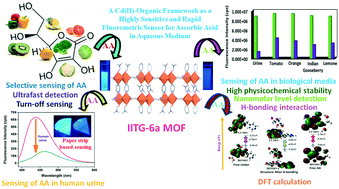A Cd(ii)-organic framework as a highly sensitive and rapid fluorometric sensor for ascorbic acid in aqueous medium†
Abstract
Ascorbic acid (AA), which plays a crucial role in human biological systems, was fluorometrically detected by a 3D Cd(II)-containing metal–organic framework (MOF) sensor, named IITG-6 (IITG = Indian Institute of Technology Guwahati). Single crystals of IITG-6 were solvothermally synthesized using a 2-((pyridin-4-ylmethyl)amino)terephthalic acid (H2BDC-NH-CH2-Py) linker. The MOF is thermally stable up to 320 °C and stable in aqueous medium. The guest free form of IITG-6 MOF (named IITG-6a) can detect AA via turn-off fluorescence response in water. The sensor exhibited a short response time (<1 min) and nanomolar detection limit (31 nM). The AA sensing capability of IITG-6a was demonstrated in different fruit and vegetable samples like tomato, orange, Indian gooseberry and lemon. The MOF also showed its selective sensing ability towards AA in a human urine sample. Moreover, test paper strips containing the MOF powder were fabricated which are suitable for onsite AA detection. By combining DFT calculations with experimental techniques, the AA sensing mechanism has been investigated.



 Please wait while we load your content...
Please wait while we load your content...